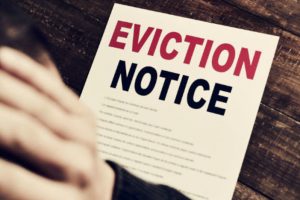 Most eviction matters handled by our firm involve conventional landlord-tenant relationships. Either in a residential or commercial context, a property owner rents property to a tenant, who pays rent to the landlord on a monthly basis. Usually, there is a written lease between the parties that delineates their rights and responsibilities to each other. When one party violates the lease, an action can be brought in the appropriate Court. For example, if the tenant fails to pay the rent due, a non-payment proceeding can be brought. If the lease has expired by its terms, and the tenant refuses to vacate, a holdover proceeding should be brought to evict the tenant.
Most eviction matters handled by our firm involve conventional landlord-tenant relationships. Either in a residential or commercial context, a property owner rents property to a tenant, who pays rent to the landlord on a monthly basis. Usually, there is a written lease between the parties that delineates their rights and responsibilities to each other. When one party violates the lease, an action can be brought in the appropriate Court. For example, if the tenant fails to pay the rent due, a non-payment proceeding can be brought. If the lease has expired by its terms, and the tenant refuses to vacate, a holdover proceeding should be brought to evict the tenant.
However, there are two common situations in which the ordinary landlord-tenant relationship does not apply, which will be discussed in this blog post. The first is when a property is sold at foreclosure. The purchaser of the property at the foreclosure sale generally buys the property “as is”, which may mean that the original owners of the property still occupy the premises. The former owners are not “tenants” in the traditional sense, as they do not have a lease with the new owner and are not paying rent to the new owner. How do the Courts handle this situation?
New York Real Property Actions and Proceedings Law, Section 713 provides the “ground rules” for eviction where no landlord-tenant relationship exists. Subsection 5 of this law relates to situations where the property has been sold in foreclosure, and there are still occupants at the premises. In this situation, the new owner of the property must first serve a ten-day notice to quit on the occupant or occupants. This is a legal notice, usually prepared by the attorneys for the new owners. It states that the occupant must vacate within ten days, or an eviction action will be brought. If the former owner refuses to vacate the premises after receiving the notice to quit, then counsel will commence an eviction action in the appropriate landlord-tenant court. The Notice to Quit must also include a certified copy of the Referee’s Deed in Foreclosure to prove the new owner’s ownership.
The second situation is when an occupant is a licensee of the owner of the property. A licensee is someone who was allowed to live at the property by the owner without a lease or payment of rent, such as a girlfriend or boyfriend of the owner. Subsection 7 of Real Property Actions and Proceedings Law, Section 713 allows the owner to terminate the license after issuing a ten-day notice to quit. If the individual does not move out within ten days, an eviction action can be brought in the appropriate legal forum.
There are other, less common situations, which are covered by this area of the law, such as when someone is a “squatter” on the property, that is, such a person never had permission of the owner to occupy the premises. In that situation a ten-day notice should be served on the occupant, followed by a holdover eviction action.
Our firm handles all types of eviction matters, including those where a traditional landlord-tenant relationship does not exist, and looks forward to your inquiries.
 New York Real Estate Lawyers Blog
New York Real Estate Lawyers Blog

